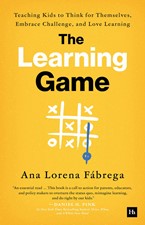Ditching Gold Stars: How to Engage Children Without Rewards
By Author Ana Lorena Fábrega

When I was a teacher, one of the first things I did every year was to create a classroom that could run itself. I didn’t want kids to engage and learn because I was hovering over them. I wanted them to be self-motivated.
My co-workers couldn’t figure out how I did it. They would use every classroom-management technique in the book. Treasure boxes filled with prizes for good behaviour. “Good work!” coupons kids could exchange for goodies. Star-shaped stickers that added up to extra break time.
But nothing seemed to work. No matter what they tried, their classrooms would devolve into chaos as soon as they left.
I said “no” to rewards. You wouldn’t find any of these things in my classroom. Still, kids stayed engaged for hours each day, diving into their favorite subjects.
I found that rewards actually hurt engagement over the long run. Extrinsic motivators like rewards may help kids reach some short-term behaviour goals, but they distract us from the ultimate goal of raising self-directed, lifelong learners.
The Problem with Extrinsic Motivators
Extrinsic motivators are common in most classrooms and homes. We reward kids when they do as they are told or remove privileges when they don’t.
The logic behind extrinsic motivators is intuitive. A behaviour that is rewarded or punished is more or less likely to be repeated. Most of the time, these work—and rather quickly. Kids who are promised a reward will often immediately change their behavior or decide to engage.
But there are a few problems with this approach:
First, rewards don’t work forever. There is a limit to how many rewards we can promise and give—after some time, these rewards become repetitive and boring. Once the short-term benefit of a reward ends, the child’s motivation fades.
Second, what are we teaching our children when we promise a reward to get them to do something?
We’re telling them that they should care about what they’ll get instead of enjoying the learning process. They do things for the reward or to avoid punishment, rather than for the sake of learning itself.
How can we raise self-directed learners if we get kids into the habit of expecting a reward for doing the right thing?
The key is in intrinsic motivation.
How to Unlock Intrinsic Motivation
We all learn best when we’re intrinsically motivated. As author Daniel Pink says, “The secret to high performance isn’t rewards and punishments, but that unseen intrinsic drive—the drive to do things for their own sake. The drive to do things ’cause they matter.”
What’s true of adults is also true of kids. They learn to love learning when they engage in activities driven by their curiosity and inner desire to explore. Kids who understand the value of what they are doing or learning stop caring about extrinsic rewards.
Here are five things I did to motivate my students intrinsically that you can try with your kids:
1. Give kids choices and make them feel accountable
Giving children choices and responsibilities builds a sense of excitement, accountability, and purpose.
I provided students with choices on what and how they learned. Even simple choices, like picking which book to read, who to work with, or where to sit, make children feel empowered. I also found that kids who are given choices are more prone to finding time outside of school to continue learning on their own—a crucial trait of self-directed learners.
I gave students specific classroom jobs that made them feel accountable. I catered jobs to their personality and inclinations. For example, my hyperactive students ran classroom errands. The most likely to misbehave became my teacher helpers.
It worked like magic! The hyperactive students were able to release energy throughout the day. The “troublemakers” felt special because they had the most important classroom jobs, so they made the effort to set a positive example. They raised to the level of expectation.
2. Involve kids when making decisions
Children who perceive they are in control are more likely to engage in their learning.
My students and I had discussions about social and behavioural expectations for our classroom, and we came up with rules and logical consequences that they understood and accepted. These agreements were reached together, and because the children had a voice and influence over these issues, they were more likely to take them seriously.
As author Polina Pompliano points out, parents can engage kids in decisions by conducting family meetings. She writes:
“Instead of taking a top-down approach, try a bottom-up approach. For instance, if you want to limit the time your kids spend in front of a screen, call a family meeting and tell them you want them to come up with fair rules. Allow your kids to be part of the rule-making process.”
When we involve children in decisions, they begin to understand the reasons behind our choices and are more likely to cooperate.
3. Be specific with feedback and questions
Children, like adults, seek recognition for their accomplishments and benefit from knowing how they are doing.
We can recognise their positive efforts and encourage them to build on their strengths by giving them specific feedback. When offering words of encouragement, we need to be specific so that children know exactly what they are doing well. Don’t just say, “Good work!” Good work on what?
Similarly, resist using generic praises such as “Well done!” or “That’s amazing!” Try asking questions about their process instead. Be curious about the how rather than praising the what. Here are some examples:
“How did you think to make that? What was your favourite part? Will you tell me more about it?”
“I saw your tower fell down and instead of getting frustrated, you took a deep breath and built it again. That was really cool to watch.”
“Wow, you scored a goal! How did that feel? Your enthusiasm for football is contagious.”
As a rule of thumb, recognise effort, not ability; ethics over achievement. Recognise the learning process, not the outcome. Recognise curiosity, perseverance, and a growth mindset over the completion of tasks.
It’s equally important to ask good questions when talking with our kids. When we ask broad questions, like “How was your day in school today?” we are likely to get broad answers, like “Good” or “Fine.” Instead, try asking more specific questions, like “What was one high and one low from your day?” (Side note: this works great with spouses too!)
4. Have frequent “why” conversations
Kids demand to know the meaning and relevance of what they’re doing and learning. And rightly so!
As author Malcolm Gladwell wrote, “Hard work is a prison sentence only if it does not have meaning.” Kids stay engaged and enjoy the process when they understand the why behind what we encourage them to do.
I framed my classroom lessons in ways that were relevant to my students’ preferences, and provided context for why each topic was important.
I noticed that children feel satisfied when engaging in meaningful dialogue. They love nurturing their curiosity and learning about adult decisions. The conversations I had with my students about the importance of certain tasks and behaviours brought meaning to their learning and made them want to engage more.
5. Make fun a priority
Children who have fun learn more and behave better than those who don’t. Similarly, when children enjoy what they are doing, they are more likely to keep doing it.
Having fun was a top priority in my class. I spent time thinking of what got me excited as a child and the things that made me feel valued and engaged, and tried to replicate them. I worked hard to bring fun to everything we did by incorporating humour and engaging in fun activities for the sake of having fun. This sent the message that learning and fun go together.
While motivating kids intrinsically is harder, it’s worth the time and effort. After all, instilling in children a love for learning is the most valuable gift we can give them.

Edited extract from The Learning Game: Teaching Kids to Think for Themselves, Embrace Challenge, and Love Learning by Ana Lorena Fábrega is published on 05 September 2023 by Harriman House.